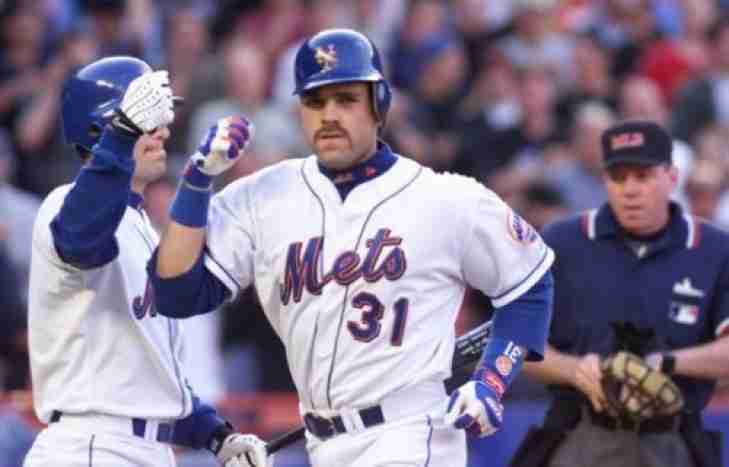20. Mike Piazza
You could easily state that Mike Piazza is a Met. That is the team he entered the Baseball Hall of Fame as, but for our money, his best statistical accomplishments were in Los Angeles.
The story of Piazza is well known, with him only being drafted at all (62nd Round, 1,390th Overall) as a favor to his father, who was friends with Tommy Lasorda. Piazza played at First Base but moved to Catcher to hope for an easier path. Not only did that work out, but he is also considered one of the best-hitting Catchers in Baseball history.
Piazza blossomed in the minors and was a late-season call-up in 1992. He was named the Dodgers' starting Catcher in 1993, and he won the Rookie of the Year, batting .318 with 35 Home Runs and 112 RBI. A Silver Slugger and All-Star that year, Piazza continued to earn those accolades annually until 2002, though he left the team well before that streak ended. His best seasons were in 1996 and 1997, with back-to-back second-place MVP finishes, with his latter year being special (40 HR, 124 RBI, .362).
As great as Piazza was, the Dodgers looked to rebuild, and they traded Piazza in May of 1998 to the Marlins, who, a week later, dealt him to New York, where he led the Mets to a Pennant win in 2000. With Los Angeles, Piazza had an OPS of .966 (higher than his Mets one of .915), and his bWAR of 32.0 was significantly greater than what he did in New York (24.6).
Piazza was chosen for Cooperstown in 2016, his fourth year on the7. Mike Piazza
He didn’t. He entered Cooperstown as a New York Met.
2016 Baseball HOF Weekend is over
For Griffey Jr., this seemed to be almost automatic from the start. The son of former star, Ken Griffey Sr., was the first ever pick in the 1987 Amateur Draft and became the first overall pick to enter the Hall of Fame. He would join the Seattle Mariners at 19 years old and was a legitimate five tool player. His overall 22 year career saw Griffey Jr. smack 630 Home Runs, go to 13 All Star Games and win 10 Gold Gloves. He made history by receiving 99.3% of the votes, the highest ever by anyone.
For Catcher, Mike Piazza, the road wasn’t so easy.
Piazza was drafted in 1988, 1,390th overall, making him the lowest drafted player to make the Baseball Hall of Fame. He was lucky to even be drafted at all, as the choice was based on a good word from Tommy Lasorda, who was a friend of Piazza’s father. Switching from First Base to Catcher, Mike Piazza would eventually hit 427 Home Runs with a .306 Batting Average and went to 12 All Star Games.
It would take Piazza four times to make the Hall.
Worth noting, is that over 50,000 people attended the ceremony, the highest amount since 1999.
We here at Notinhalloffame.com would like to congratulate Ken Griffey Jr. and Mike Piazza for earning this prestigious honor.
The New York Mets Will Retire Mike Piazza's Number.
Piazza joined the New York Mets following a trade from the Florida Marlins in 1998 and over a nearly 1,000 Game Career with the Mets, Piazza earned six All Star nods and three Silver Slugger Awards. He would accumulate 1,028 Hits, 220 Home Runs, with a Slash Line of .296/.373/.542 Slash Line with a bWAR of 30.5.
The retirement of Mike Piazza’s number #31 will be the fourth Met to have his number retired. This follows Tom Seaver, Gil Hodges and Casey Stengel to have this accolade.
The ceremony will take place prior to a game against the Colorado Rockies on July 30th.
We would like to congratulate Mike Piazza for achieving this latest accolade.
Awards = HOF? Part Five: The Silver Slugger (Catcher) (MLB)
Needless to say, different awards in different sports yield hall of fame potential. In basketball, the team sport with the least amount of players on a roster, the dividend for greatness much higher. In baseball, it is not as much as a great individual season does not have the same impact.
Awards = HOF? Part Three: The Rookie of the Year (MLB)
We here at Notinhalloffame.com thought it would be fun to take a look at the major awards in North American team sports and see how it translates into Hall of Fame potential.
The 2016 Baseball HOF Ballot is officially out!
Let’s go through the ballot and take a quick look shall we?
IF I HAD A VOTE IN THE 2013 BASEBALL HALL OF FAME ELECTION, PART 1: A HISTORIC REFERENDUM
Note: Part 1 of this two-part series goes into detail—considerable detail—to examine both the overstuffed ballot and, more comprehensively, the atmosphere of moral dudgeon surrounding the suspected and admitted usage of PEDs by players on previous ballots and especially by players eligible for the Hall for the first time this year. If you want only to read the players' evaluations, skip to Part 2.








